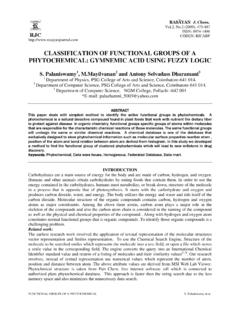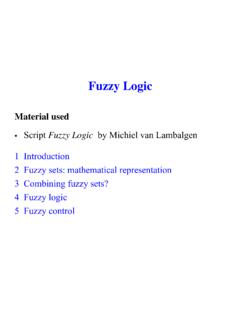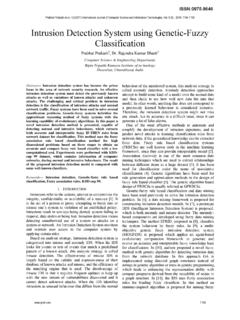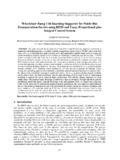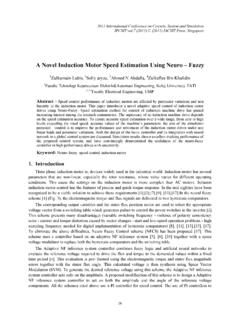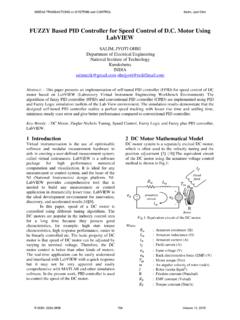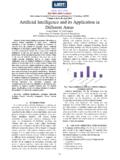Transcription of The Germ Theory and Koch’s Postulates
1 Science Enhanced Scope and Sequence Biology Virginia Department of Education 2012 1 The germ Theory and koch s Postulates Strand Interaction of Life Forms Topic Investigating the germ Theory of infectious disease and koch s Postulates Primary SOL The student will investigate and understand life functions of Archaea, Bacteria, and Eukarya. Key concepts include d) human health issues, human anatomy, and body systems; f) evidence supporting the germ Theory of infectious disease. Related SOL The student will demonstrate an understanding of scientific reasoning, logic, and the nature of science by planning and conducting investigations in which a) observations of living organisms are recorded in the lab and in the field; c) variables are defined and investigations are designed to test hypotheses; e) conclusions are formed based on recorded quantitative and qualitative data.
2 Background Information Diseases can be spread by air, water, food, and human and animal vectors. In 1854, English physician John Snow found a relationship between polluted water and disease. Then, in 1884, German microbiologist Robert koch isolated the bacteria Vibrio cholera, the cause of cholera, from water taken from Germany s Elbe River, thus proving the relationship between polluted water and this disease. koch went on to formulate an established set of procedures to isolate and identify the causative agent of a particular microbial disease. The following four steps, which are still used today, are known as koch s Postulates : 1. Postulate 1: A specific organism must always be observed in association with the disease. 2. Postulate 2: The organism must be isolated from an infected host and grown in pure culture in the laboratory. 3. Postulate 3: When the organism from the pure culture is inoculated into a susceptible host organism, it must cause the disease.
3 4. Postulate 4: The infectious organism must be re-isolated from the diseased organism and grown in pure culture. Materials koch s Postulates handout (attached) Oranges Culture of Penicillium italicam, grown on potato dextrose agar (PDA) Beakers or jars large enough to hold two oranges Dissecting needles Bunsen burners 10%-bleach solution Cool, soapy water Clean scrub brushes Fine-point permanent marker Science Enhanced Scope and Sequence Biology Virginia Department of Education 2012 2 Graph paper with 1-cm squares Clear, zip-top plastic bags Sterile swabs Petri dishes Potato dextrose agar Vocabulary agar, aseptic, germ Theory of infectious disease, pathogen, petri dish, postulate, Theory Student/Teacher Actions (what students and teachers should be doing to facilitate learning) It is recommended that this microbiology laboratory activity be completed in the spring when students are more adept at inquiry and lab safety.
4 In this lesson, students will test the four Postulates established by koch . They will observe and record mold growth on fruit and in a laboratory petri dish. From these observations, they will determine whether the mold grown on the fruit and that in the petri dish are the same kind of mold, thus proving koch s Postulates . They will also practice aseptic laboratory techniques and isolation of microorganisms. Because mold growth is slow, the actual in-class time will be minimal after the initial laboratory setup. The activity will take place over a minimum of four weeks, depending upon the amount of time needed for the mold, Penicillium italicam, to grow and sporulate. This amount of time depends upon the viability of the culture and the warmth of the incubation area. Students will monitor and record daily the changes in the oranges and PDA plates. They will record mold growth when approximately half of the observable mold has sporulated (changed from fuzzy white to blue-green).
5 Prepare for the activity by using a fine-point permanent marker to draw a 10 x 10 centimeter grid on each clear, zip-top plastic bag. Use the 1-cm graph paper as a pattern to trace. These grids will be used to count representative mold samples on the oranges. 1. Introduce John Snow, and discuss The Broad Street Pump Outbreak of cholera. Discuss John Snow s response to the outbreak and how the scientific community reacted when his work was published. (For more information, search online, using keywords such as John Snow, cholera, and Broad Street Pump Outbreak. ) 2. Introduce students to the miasma Theory of infectious disease, the germ Theory of infectious disease, and koch s Postulates , discussing how each of these helped to explain microbial disease epidemics. 3. Explain to students that they will test each of koch s Postulates , using fruit and fruit mold to simulate diseased host organisms and the infectious agents or pathogens that cause disease.
6 Distribute copies of the attached koch s Postulates handout, and have students work in groups of two or three to accomplish the experimental steps listed. Assessment Questions o In testing Postulate 1, what did the unwashed and unbleached, unpunctured, uninoculated orange test? Science Enhanced Scope and Sequence Biology Virginia Department of Education 2012 3 o For Postulates 1 and 3, what did the washed and bleached, punctured, uninoculated orange test? o What were the constants in this experiment? o What was the independent variable (IV) for each postulate? o What was the dependent variable (DV) for each postulate? o Why must the lab tops be disinfected? o Why must the dissecting needles be flamed? o Why should the oranges be scrubbed? o What was the purpose of putting the oranges in the bleach solution? o Why have koch s Postulates remained unchanged since 1884?
7 O What did the oranges and the mold represent, using the terminology from koch s Postulates ? o Did the same mold infect the organism the second time? Support your answer, using your data table. Journal/Writing Prompts o Have students research a communicable disease they may have had. Have them include where they contracted the disease, whether they gave it to anyone else, how it is transmitted, and how others could be protected from getting it. o Describe the changes that took place in municipal water supplies as a result of John Snow s work. Other o Have students observe that both the oranges and the PDA produced a white fuzzy mold that turned blue-green and/or green when it sporulated. Have them also observe and record the time from inoculation to when some mold first appeared and when the mold first sporulated. Extensions and Connections (for all students) Have students formulate a hypothesis for each postulate.
8 Have students design a method to measure accurately the amount of mold growth on an orange and in a petri dish. Direct students to research triclosan, a common ingredient in antibacterial soap, and describe its uses. Have them also summarize any problems that may be associated with its use. Strategies for Differentiation Run this lab as a teacher-demonstration to be followed by a student discussion of the results. Run this lab in advance, film or photograph its progress, and then show the video or series of photos. Follow the viewing with a student discussion. Have students design an experiment but not actually run it. Science Enhanced Scope and Sequence Biology Virginia Department of Education 2012 4 koch s Postulates Postulate 1: A specific organism must always be observed in association with the disease. Procedure 1. Clean lab tops with disinfectant or bleach solution.
9 2. Obtain three oranges. Set one orange aside. Wash the other two in cool, soapy water, scrubbing them thoroughly with a scrub brush. Rinse in clear running water. 3. Place the two washed oranges in a large beaker or jar. Cover them with a 10%-bleach solution. Let them soak for 10 minutes. 4. Rinse the bleached oranges in clear running water for 10 minutes. 5. Place the dissecting needle into the Bunsen burner flame, and allow it to cool. Pierce the skins of both bleached oranges three or four times with the needle. 6. Flame the mouth of the tube containing the Penicillium italicam. Using a sterile swab, aseptically remove a small sample of the culture, and smear it over the punctures in one of the punctured oranges. Do not inoculate the other punctured orange. 7. Place each of the three oranges in a separate plastic bag with a 10 x 10 centimeter grid drawn on it.
10 Do not seal the bags: they must remain aerobic during the incubation time. 8. Label each bag with three labels: Washed and bleached or Unwashed and unbleached, Punctured or Unpunctured, and Inoculated with mold or Uninoculated with mold. Also, put the date and the initials of the group members on the bags. Allow the bags to sit at room temperature for about a week. 9. Record daily observations in the data tables below. For each orange, carefully line up the 10 x 10 cm grid with a representative part of the orange, trying not to disturb the mold growth. Count the number of squares in which fuzzy colonies of white or blue-green mold are apparent. Record the number on the data table below as an actual count (x squares 100 squares) or as a percentage. 10. When the fuzzy white mold turns blue-green and/or green, the mold has sporulated and can be isolated and grown in pure culture on a special agar , potato dextrose agar (PDA).










